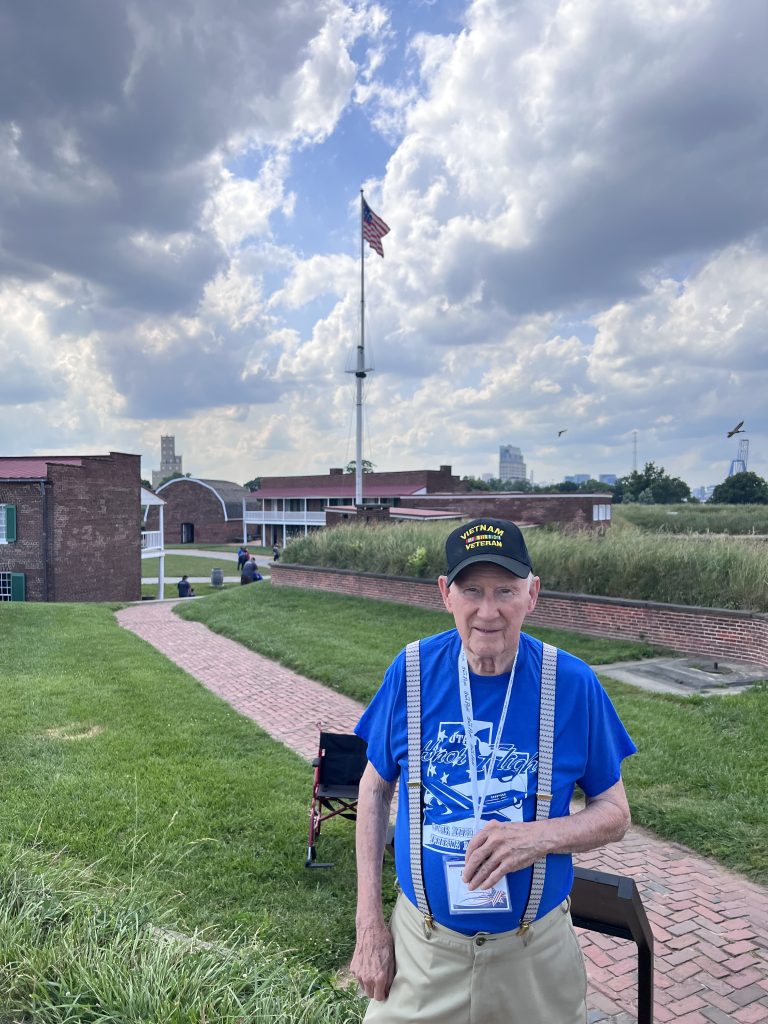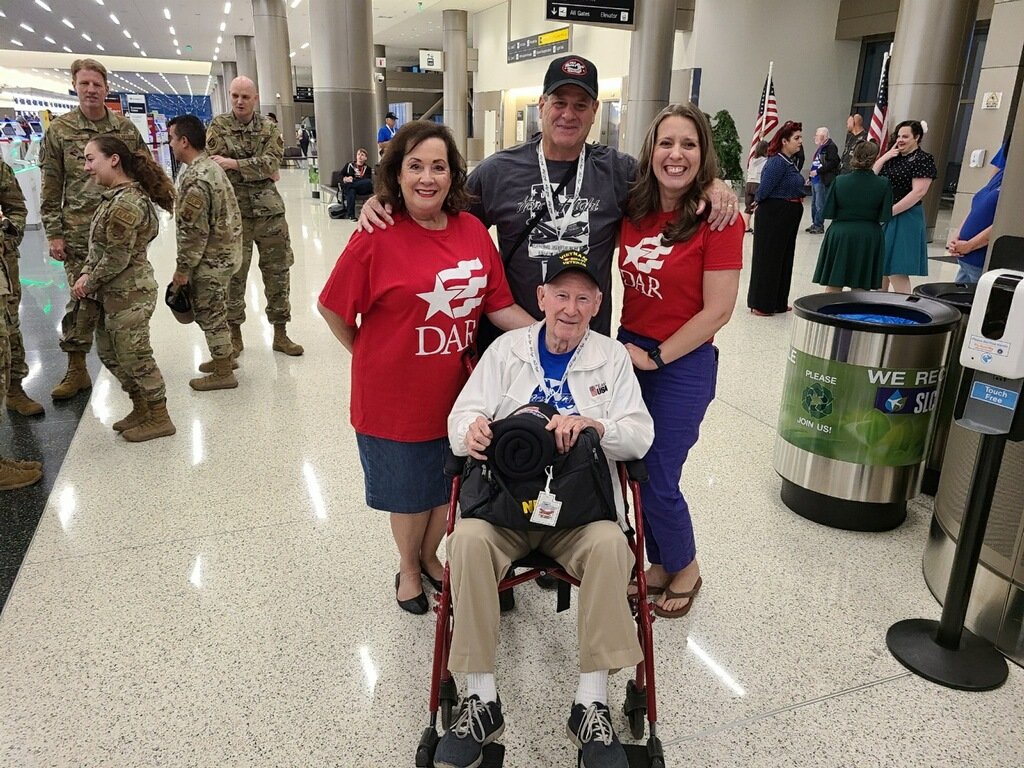ST. GEORGE — Behind enemy lines, you get close to your fellow service members. No man is left behind.
There often is no time to think. Only time to act.
And lives depend upon it.
James Harper of Santa Clara remembers what this was like while serving in Vietnam. Memories came flooding back of his time as an Air Force Special Operations pilot during his recent Utah Honor Flight to Washington, D.C.
Harper’s tour of the nation’s capital allowed him and his son to take in the monuments dedicated to America’s freedom. During his military service, Harper and many others put their lives at risk – and did so willingly.
“We were trying to fly at night and during the day. If it was at night, we flew at a low level of 200 feet,” Harper said. “If you were to take a special forces team to a landing zone or a drop zone, it had to be clandestine; you didn’t want to get caught.”
Harper has waited three years, thanks to the pandemic before he could travel on a Utah Honor Flight. In June, Harper, 88 years old, traveled with his oldest son Martin to visit the war memorials in Washington, D.C., with the Utah Honor Flight.

Harper was in the Air Force Special Operations and flew the C-47 plane in Vietnam in 1962 and 1963. He said he was touched when they visited the Vietnam War Memorial.
“I stopped counting at 22. But I know there were more men than that,” Harper said. “And some of those guys and I were pretty close.”
Harper graduated from high school in 1952 and later graduated from Purdue University in Air Transportation Engineering. When he received another draft notice, he went to Indianapolis and enlisted in the Air Force.
During the Vietnam War, Harper experienced “esprit de corps” – a feeling of pride and fellowship shared by members of the Air Force.

“Serving in the war, afterward it was special, not while you’re doing it particularly,” Harper said. “The best place in the military is special operations. In the army, it’s the Green Berets and in the Navy, it’s SEALs, and in the Air Force, it’s our Commandos. There isn’t anything better than their esprit de corps in those units because everyone is dedicated.”
Martin Harper said it was an honor to escort his father on the Utah Honor Flight. Only one other person could go with Harper.
“He was very excited about it,” Martin said. “My dad was like a little kid to me. He was thrilled.”
Martin Harper said at many sites the group toured, people and children of all ages thanked the veterans for their service. One of Martin Harper’s favorite moments on the trip was when they were at the National Mall and it was sweltering. They wanted ice cream from an ice cream truck, but the line was long. His father got in the line and the next thing he noticed was his father was suddenly at the front of the line.
“People said, ‘Oh, you’re a veteran. Why don’t you go ahead and order ahead of us?’ which is kind of touching,” Martin Harper said. “I think it was really respectful.”
Jim Harper’s experience was when warfare was very “rudimentary.” During the Vietnam War, Harper said every SEAL team on a mission has at least one Air Force, special operations and tactics team assigned to them.
Soldiers had a physical map and had to know the coordinates of artillery and friendly forces. The targets were marked with phosphorus flares. Then the fighters were called in one at a time to strike the targets.
Harper recommends the book “Hit My Smoke” by Jan Churchill to understand his experience. Harper considers himself as being “very fortunate to serve” during that era. He recalled his intense missions.
“We were trying to fly at night and during the day. If it was at night, we flew at a low level of 200 feet,” Harper said. “If you were to take a special forces team to a landing zone or a drop zone, it had to be clandestine; you didn’t want to get caught.”
Harper said he was lucky he served early in the war because the enemy didn’t have the big anti-aircraft guns when he was there.
“They had smaller arms and they were shooting at us,” Harper said.
He remembered the dark-skinned indigenous mountain people known as the Montagnards. They were recruited into service by the American Special Forces in Vietnam against the Viet Cong and served as rapid response forces. The Montagnards had around six tribes up and down the mountains where Harper was near.
Special camps were set up for the U.S. special forces team to train them for self-defense. The tribal chiefs requested this because they had no weapons except blow guns and crossovers to fight against the Viet Cong taxing them. Harper said the Montagnard would be attacked if they couldn’t pay the tax. There were 30 tribes Montagnard total in Vietnam.
“We worked with the Green Berets to set up these Special camps. We took them sandbags and barbed wire, so they were setting up their camps and we defended them when they came under attack,” Harper said.
The Montagnards already had an uneasy relationship with Vietnam’s various central governments by the time the United States Special Forces first arrived in Vietnam in the early 1960s.
“The province chief would call the CIA down in Saigon and say, ‘We need a special forces team for this village.’ And so we would go down and pick up the team and deliver a man, we just air-landed him closest to the province chief headquarters, and then they’d meet the village chief,” Harper said.
Harper also recalls how the Montagnards were out at night fighting. The U.S. troops didn’t fight at night; they hunkered down in their bunkers, hoping they didn’t get attacked. But the Viet Cong were coming at night.
After Harper’s service in Vietnam, he met his wife Beverly at Travis Air Force Base in California. He took a position in Germany teaching pilots and setting up a new squadron for those heading to the war. They stayed in Germany for three years. Then he left the military and the couple moved to Beverly’s hometown of Riverside, California, where they owned a hobby business for 35 years. The company also had outlets in Riverside, San Bernardino, and Reno, Nevada.
The Harpers moved to Santa Clara in 2006. He enjoys reading war books and model trains. Harper loves spending time with his family. He has two sons, three girls, 18 grandchildren and 16 great-grandchildren.
Photo gallery

Brigadier General Max J. Stitzer, Mobilization Assistant to the Air Force Director of Staff, Headquarters, United States Air Force visits with James Harper during his Utah Honor Flight to Washington D.C. | Photo provided by James Harper, St. George News

James Harper who is a Vietnam vet with the group of veterans from Utah visiting the monuments in our nation's capital, Washington D.C. | Photo provided by James Harper, St. George News

James Harper served in the Air Force Special Operations in 1962 and 1963 in Vietnam and flew the C-47 plane and he enjoyed his visit to the Air Force memorial wall which commemorates the Air Force virtues, Washington D.C. | Photo provided by James Harper, St. George News

James Harper visits Fort McHenry with the original flagpole in the background which flew the stars spangled banner that inspired Francis Scott Key to write the National Anthem, Baltimore, Maryland | Photo provided by James Harper, St. George News

James Harper in his home with his collection was glad to go on a recent Utah Honor Flight, Santa Clara, Utah, July 1, 2022 | Photo by Stephanie DeGraw, St. George News

Jim Harper (seated) with son, Martin, behind him and on the left is Utah State Daughters of the American Revolution Regent Kathryn Asay and on the right is Utah Daughters of the American Revolution member Danielle Cahoon before leaving for the Utah Honor Flight, Salt Lake City, Utah, June 7, 2022 | Photo provided by Utah State Society Daughters of the American Revolution, St. George News